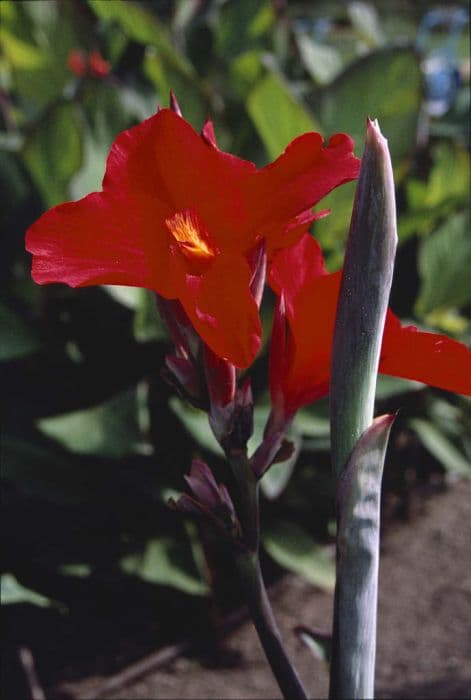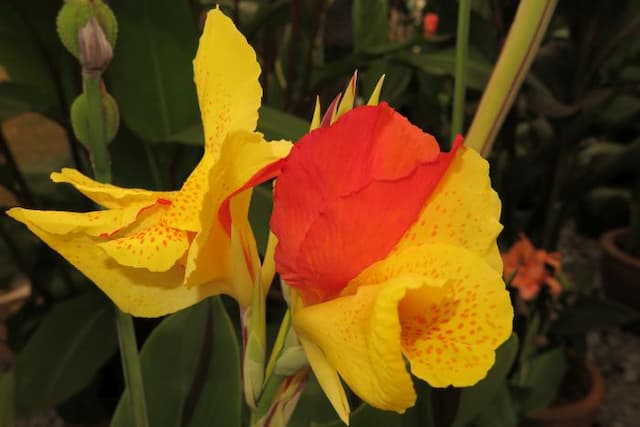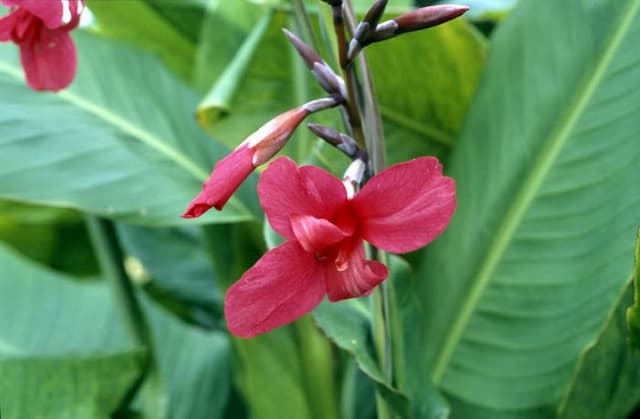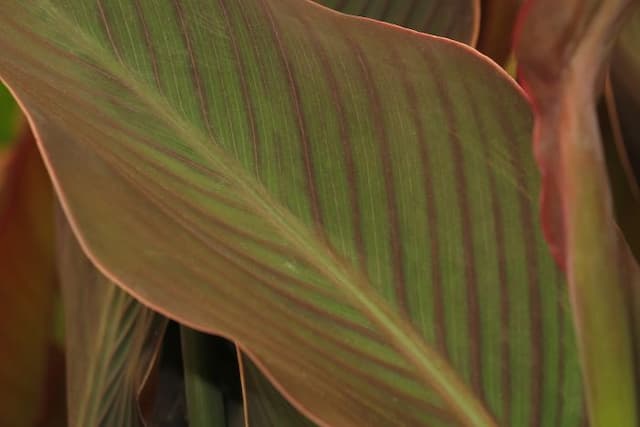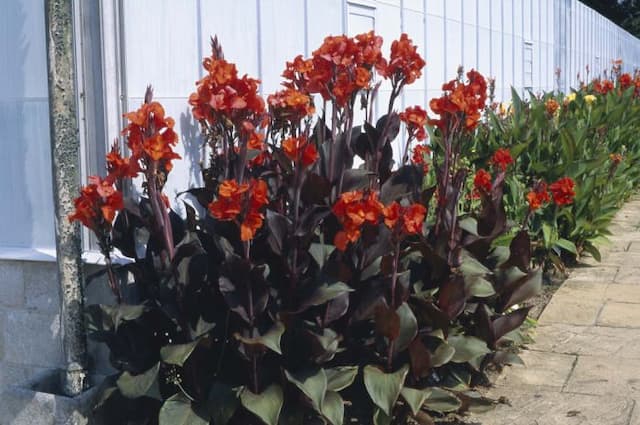Canna Lily Canna 'President'

ABOUT
The Canna 'President' is a vibrant tropical flowering plant known for its bold and striking features. Boasting large, paddle-shaped leaves, the foliage presents a lush green backdrop that can sometimes have hints of bronzy or purplish coloration, depending on the variety and growing conditions. The true showstoppers of the plant are its flowers. They emerge in clusters on tall spikes that rise above the foliage and captivate onlookers with their brilliant red hue. Each flower of the Canna 'President' exhibits a classic canna shape, resembling an iris, with petals that unfurl to reveal a stamen that often stands out in a contrasting color, adding to the plant's ornamental appeal. The flowers are known for their lustrous sheen and can have a somewhat ruffled look, which enhances their texture and depth. The plant itself conveys a tropical aesthetic and can add a splash of color to any garden setting. The Canna 'President' is a perennial favorite among gardeners who desire an element of exotic beauty and a touch of elegance without needing much maintenance. Aside from the stunning flowers and lush leaves, the plant does not have any distinctive smell, allowing it to blend seamlessly into various garden compositions without overpowering with fragrance. Overall, the Canna 'President' is a captivating plant that is sure to draw attention and add a dramatic flair to any space where it is grown.
About this plant
 Names
NamesSynonyms
Canna Lily, Canna.
Common names
Canna 'President'
 Toxicity
ToxicityTo humans
The Canna is generally not considered toxic to humans. It doesn't typically cause serious symptoms if ingested, and there are no well-documented cases of poisoning from eating parts of the plant. However, as with any plant material, individual reactions can vary, and ingesting Canna could potentially cause mild stomach upset in sensitive individuals.
To pets
The Canna is not known to be toxic to pets such as cats and dogs. It's not associated with serious health problems if pets consume parts of the plant. Nevertheless, ingestion may result in mild gastrointestinal discomfort or an upset stomach in some pets, but significant or life-threatening toxicity is unlikely.
 Characteristics
CharacteristicsLife cycle
Perennials
Foliage type
Deciduous
Color of leaves
Green
Flower color
Red
Height
3-4 feet (0.9-1.2 meters)
Spread
1.5-2 feet (0.45-0.6 meters)
Plant type
Bulb
Hardiness zones
7-10
Native area
South America
Benefits
 General Benefits
General Benefits- Vibrant Flowers: Canna 'President' has large, showy red flowers that add a bold splash of color to any garden.
- Easy to Grow: This plant is known for being low-maintenance and easy to care for, making it suitable for gardeners of all skill levels.
- Attracts Pollinators: The flowers of the Canna 'President' attract bees, butterflies, and hummingbirds, promoting pollination in the garden.
- Architectural Foliage: Its large, banana-like leaves provide a tropical look and add structure and texture to garden beds and borders.
- Fast Growing: Can grow quickly to fill in spaces, making it a good choice for areas that need fast coverage.
- Drought Tolerant: Once established, it can tolerate periods of drought, reducing the need for frequent watering.
- Versatile Landscaping: Suitable for use in mixed borders, as a focal point, or in large containers, it offers flexibility in garden design.
- Long Blooming: The flowering season is relatively long, providing color from early summer until the first frost.
 Medical Properties
Medical PropertiesThis plant is not used for medical purposes.
 Air-purifying Qualities
Air-purifying QualitiesThis plant is not specifically known for air purifying qualities.
 Other Uses
Other Uses- Fiber Production: The stem of the Canna plant can be processed to extract fibers for making paper or fabrics.
- Biomass: Canna plants can be used as a source of biomass for bioenergy production due to their high growth rate.
- Edible Oil: Seeds of the Canna plant may be pressed to extract oil, which is sometimes used in cooking or as a salad dressing.
- Water Filtration: Canna plants can be used in constructed wetlands to help filter and clean wastewater.
- Erosion Control: Due to its robust root system, planting Cannas along waterways can help reduce soil erosion.
- Aquatic Gardening: Varieties of Canna are well-suited for growing in water gardens or as marginal water plants.
- Dye Production: The leaves of the Canna plant can be used to create natural dyes for coloring fabrics and craft materials.
- Seasonal Interest: Gardeners may plant Cannas for their seasonal foliage that can provide aesthetic interest even when the plant is not flowering.
- Pond Remediation: Canna plants can absorb certain heavy metals from water, making them useful in pond remediation projects.
- Handicrafts: Dried parts of the Canna plant, especially the leaves and seed pods, can be used in crafting decorative items.
Interesting Facts
 Feng Shui
Feng ShuiThe Canna is not used in Feng Shui practice.
 Zodiac Sign Compitability
Zodiac Sign CompitabilityThe Canna is not used in astrology practice.
 Plant Symbolism
Plant Symbolism- Prosperity: The Canna 'President', being a lush and vibrant flowering plant, is often associated with abundance and wealth.
- Vibrancy: With its bright red flowers, the Canna 'President' symbolizes energy and enthusiasm, radiating a sense of vitality.
- Confidence: The bold and striking appearance of the Canna 'President' can be reflective of confidence and pride, mirroring the strength and certainty of a leader.
- Change and Transformation: Cannas are known for their ability to adapt and grow in various conditions, symbolizing the capacity for transformation and flexibility in life.
- Beauty: The stunning appearance of the Canna 'President' makes it a symbol of beauty and aesthetic appreciation.
 Water
WaterCanna Lilies, including the Canna 'President', should be watered to keep the soil consistently moist but not soggy. During the growing season, watering may be necessary approximately once a week, but this can vary depending on the climate and weather conditions. Typically, one inch of water per week, including rainfall, is sufficient. Water the plant directly at the base to avoid wetting the foliage, which can lead to fungal diseases. If the plant is in a container, ensure it has adequate drainage and water until it runs out of the bottom of the pot. Adjust watering frequency during hot, dry periods, as the plant may require additional water to prevent stress.
 Light
LightCanna Lilies thrive best in full sun conditions, receiving at least six to eight hours of direct sunlight per day. The Canna 'President' should be placed in a spot where it is exposed to ample sunlight, which promotes vigorous growth and optimal flowering. However, in extremely hot climates, a little afternoon shade can be beneficial to prevent scorching.
 Temperature
TemperatureCanna Lilies, such as the Canna 'President', prefer warm temperatures and perform best when the temperature is between 70 to 90 degrees Fahrenheit. They can survive minimum temperatures of around 60 degrees Fahrenheit but may cease to grow. These plants cannot tolerate frost and must be protected or moved indoors if temperatures drop below 60 degrees Fahrenheit.
 Pruning
PruningPruning Canna Lilies is primarily done to remove spent flowers and improve the appearance of the plant. The Canna 'President' should be deadheaded by cutting the spent flower stalks down to the next side shoot. This encourages the plant to produce more blooms. After the first frost in fall or early winter, the foliage should be cut back to a few inches above the ground to prepare for winter dormancy. The best time for pruning is either after flowering or when preparing the plant for winter.
 Cleaning
CleaningAs needed
 Soil
SoilThe best soil mix for Canna Lily 'President' should be rich, well-draining, and have a pH ranging from 6.0 to 6.5. A combination of loamy soil with compost and peat or coir for moisture retention works well.
 Repotting
RepottingCanna Lily 'President' should be repotted every 2 to 3 years or when the rhizomes outgrow their current container. It is best done in early spring before the growing season starts.
 Humidity & Misting
Humidity & MistingCanna Lily 'President' thrives in moderate to high humidity levels, but it is quite adaptable and does not require specific humidity conditions for healthy growth.
 Suitable locations
Suitable locationsIndoor
Provide bright light, warm temps, and regular watering.
Outdoor
Full sun, rich soil, consistent watering, and protect from frost.
Hardiness zone
7-11 USDA
 Life cycle
Life cycleThe Canna 'President', commonly known as Canna Lily, begins its life as a rhizome, which is a type of underground stem that sends out roots and shoots. Upon planting, the rhizome sprouts and a shoot emerges from the soil, developing into a stalk with large, paddle-shaped leaves. As the plant grows, a flower spike forms, which then blooms into vibrant red flowers that are a key characteristic of the 'President' variety. After pollination, the flowers are followed by seed pods, although Canna Lilies often propagate vegetatively rather than by seed. If conditions allow, the plant enters a dormancy phase during colder months, with the foliage dying back, and the rhizome surviving underground. With the return of warmer temperatures, the Canna Lily 'President' resumes growth from the rhizome, starting anew the cycle of growth and bloom.
 Propogation
PropogationPropogation time
Spring to summer
Propogation: The Canna 'President', commonly known as the President Canna, is typically propagated through division since they grow from rhizomes. The best time to propagate the President Canna is in the spring, just before the growing season begins, when the rhizomes can be divided and planted without the stress of cold temperatures. To propagate by division, you should carefully dig up the clumps of rhizomes after the foliage has died back or just as growth begins to emerge. With a sharp knife, divide the rhizomes ensuring that each section has at least one eye or growing point. These sections can then be replanted at a depth of about 4 inches (10 cm) making sure the eyes are facing upwards, and spaced about 12 to 18 inches (30 to 46 cm) apart to allow for sufficient growing space. Keep the soil moist and wait for the warmth and light of spring to encourage the rhizomes to sprout and establish themselves as new President Cannas.

